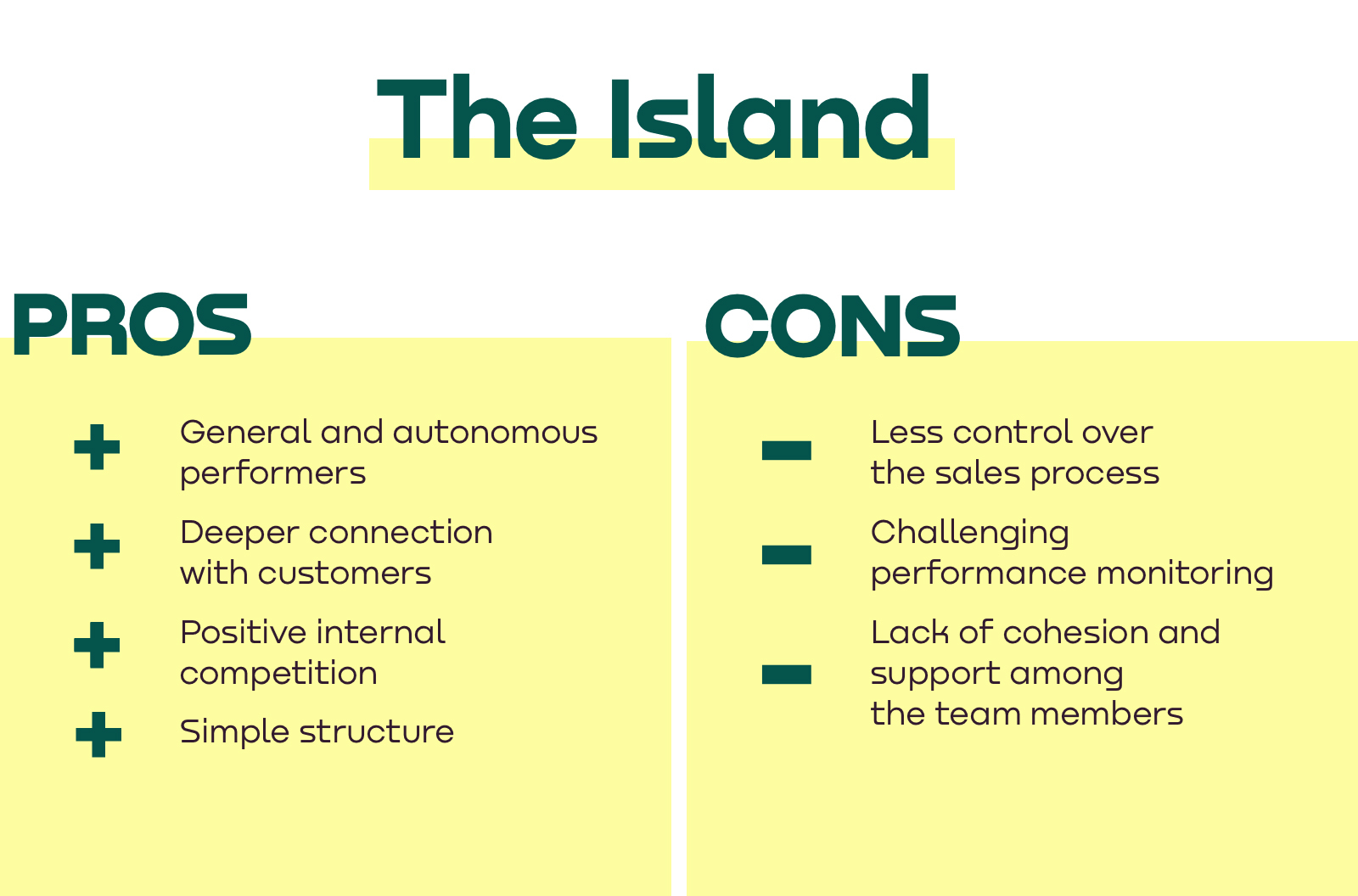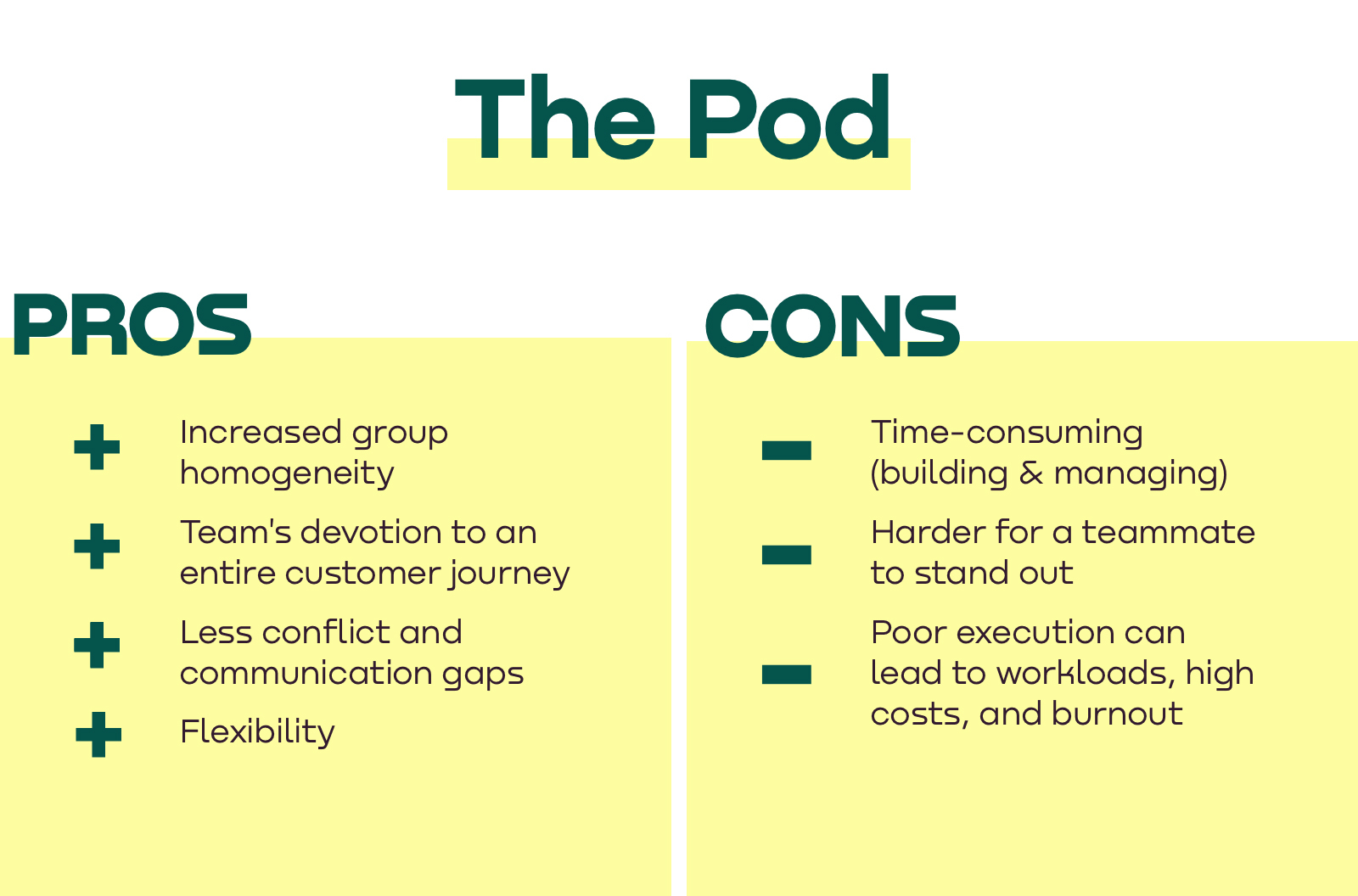- MAIN PAGE
- – elvtr magazine – HOW TO BUILD GREAT SALES TEAMS
HOW TO BUILD GREAT SALES TEAMS

Sales Manager role is surely a comprehensive one. When we asked Lilah Jones, the Head of Corporate Sales @ Google about the science and art of selling, she answered:
"You certainly need to have those brush-your-teeth types of exercises where you literally analyze data points and use lots of science to know whether you’re making the difference.
But there’s also the artistic part. And I feel that those are the soft skills, the ability to read a room, how to be ok with asking questions that make people answer “no” — to address those objections. That is phenomenal art."
LILAH JONES/
GOOGLE
However, there’s more in sales management than just selling. There's also a managerial part that includes team assembly and curation.
To navigate you through the key aspects of building and managing a sales team, we’ll dive into the following:
- How to build a sales team?
- What are the core sales team roles?
- Expert's perspective on sales management challenges and trends.
HOW TO BUILD A SALES TEAM?
Regardless of the generic sales team models outlined below, it doesn’t mean you have to frame your team into any of them per se. They’re not carved in stone but rather customizable to your requirements and resources.
You might be a solopreneur with annual revenue growth of 300% and ready to expand, or an established sales rep in a mid-size company next in line for a promotion to a sales manager.
In any case, your business and the market you operate in are specific and call for an inward analysis first. Before taking action and hiring new talent, think about how they would fit into your company’s culture, assets, and objectives.
After looking inside, make sure to review your customer base. This is especially critical today, as the crisis guided by the pandemic forces you to completely rethink the buyer’s journey and how the shifts in customer behavior affect organizational design.
It’s your responsibility to come up with an adequate sales team model and leverage it in the process of building and managing a high-performing team. Start by understanding the three most well-known and in practice mostly applied sales models: the island, the assembly line, and the pod.
1. The island
Key aspects that characterize this sales model are generality, autonomy, and competitiveness.
The word “island” proposes that every member within such a structure is an independent and self-sustaining piece of the mechanism. He is not a specialist, but rather a generalist holding a set of skills and the ability to single-handedly transform a prospect into a promoter. Technically, if viewed from the perspective of “the pod” (explained later), a sales rep like this is a team in itself.
While such a setting expands limits of action and authority, leading to more autonomy and a closer connection with customers, it adds pressure on the sales rep to deliver.
Moreover, this sales management model entails that each team member finds competition not only in outside players but also among his own colleagues. Betting on oneself and not being affected by the collective efforts can be liberating for some, and for others – unsettling. A well-thought-out hiring process in pursuit of experience and attitude is one way of choosing the right candidates.
Is “the island” model right for you then?
Yes, if you’re searching for simplicity and want to rely on aggressive individual performers that can allow for lower spending per acquisition. Some noticeable industries that typically opt for this model include real estate and financial services. Both rely heavily on close and trustworthy sales-customer relationships.
2. The assembly line
Opposite to “the island” model where each team member is equipped with A-Z sales techniques, the “assembly line” structure consists of individual specialists that operate linearly. It resembles and derives its name from the factory conveyor where the raw material travels from station to station and gradually turns to an end product.
Just like a product is moved along the tangible track, a customer moves through the buyer’s journey while being provided individual care by a different specialist in each phase.
Integration and information streams between all moving parts start to gain a lot more significance. Every member of a team is in contact with a prospect in a different moment of its maturity and it is thus critical to pay close attention and pass on the right data. It becomes the only way to qualify the right leads and keep them warm.
Usually, “the assembly line” is comprised of four different sales compartments each of which fulfills a different purpose:
- Lead generators: the ones who recognize leads, separate them from the prospects, identify their pain-points, and send them down the pipeline along with information such as names, phone numbers, emails, and other relevant findings.
- Sales Development Representatives (SDRs): they build on the research done by the lead generator and further qualify leads and confirm their authenticity; they can ask more refined questions and try to understand the decision-making processes to locate the tipping points.
- Account Executives (AEs): after a lead has been recognized and qualified for sales, account executives come into play; they chase a sale and make themselves fully available by answering questions, giving presentations, addressing remarks, and more, all with the objective to close the deal.
- Customer Success team: if everything before the sale is considered a party, a customer success team hosts the afterparty; they manage existing customers, educate them, solve their burning issues, introduce new features, and by doing so deepen and prolong the customer’s trust.
It is evident how a data-driven structure like this ensures an opportunity to locate deadlocks and optimize processes with more ease. If a lead generator secures a number of leads and only an insignificant proportion of those are passed on from a sales rep to an account executive, it’s a signal that the assembly is out of tune.
On the other hand, as much as it seemingly compensates for functionality, it lacks a more personal touch with the prospects. That’s still no reason to overlook the benefits, as nothing is unsolvable with a little analysis and training. Irrespective, as noted earlier, the only right model for your operations is the one suited to your needs and assets.
3. The pod
If you’re considering “the pod” structure for your sales team, your company has most likely matured enough to seek seamless and smoother processes.
While “the assembly line” builds on the framework of “the island”, this model has the best from both worlds: a single pod trails a particular customer throughout the entire customer journey, and each pod is filled with sales specialists in charge of specific tasks.
In other words, this model allows for a certain extent of specialization and customer-centricity in the same box.
Here’s a brief overview of building “the pod” sales team:
As you can tell, contrary to the linearity of “the assembly line”, pods represent rounded units that work together all the way and are clearly separated from each other. Most often, a unit will comprise six people including lead generators, SDRs, AEs, and customer success specialists.
It’s a much more sophisticated structure and an expected choice for a large organization with abundant resources that competes in a variety of product/service lines, regions, customer categories, etc.
While a powerful model, it comes with an equal amount of responsibility. It’s much more complex to build a model like this, let alone to maintain it. However, exclusive skills, drive, and discipline dispersed among the team members can vouch for fruitful results.
WHAT ARE THE CORE SALES TEAM ROLES?
Hopefully, by now you have recognized a sales team model that would best fit your company. If not, that’s ok too. Don’t feel pressured to cram your sales specialists within a framework that’s just too tight or too wide.
On the contrary, decide on your sales team structure based on what you got, including existing team members, processes, offer and industry specifics, budgets, competition tempo, vision, and any other factor that you value.
When you know your strengths and weaknesses and are halfway from framing your team in a sales model, it’s time to think about the core sales roles that you could fill your team with.
No matter the size of your team, they will all grind in the same direction: pushing prospects down the line. That’s why you need to make sure that you are not missing any important roles, as well as that none of them are redundant.
Here’s what you can work with:
- Sales Development Representative
As already mentioned, SDRs don’t really sell, not directly at least. They talk to leads and gather information on their needs, problems, processes, projects, intentions, etc. After collecting enough valuable clues, they pass them along to the next player in line who then continues to work towards closing the deal.
Key activity: research
- Account Executive
On the flipside, AEs are the default salespeople who feed on data collected by SDRs. Their experience and reputation allow them to form a more meaningful relationship with sales-qualified leads and take them past the finish line.
Key activity: nurturing and closing
- Sales Engineer
Sales engineers study and explain product technicalities to potential and existing customers, as well as to the rest of the sales team. They use their tech-savviness to suggest product adjustments and to convince customers of their perks and benefits. The more complex the product, the greater the need for sales engineers.
Key activity: product knowledge sharing
- Customer Service
Customer service is there to answer any questions and clarify ambiguities that the prospects and customers may have. Those can relate to anything from product performance, service delivery, prices, additional features, maintenance, etc. Whatever the pain, a customer service rep should be able to deliver a quick and reliable solution.
Key activity: ensuring customer success
- Sales Trainer
They’re responsible for upgrading the team’s knowledge and skills. By observing the team at work and closely following trends, they are able to recognize which team members or parts of the process need perfecting and provide efficient sales methods and techniques.
Key activity: sales team education
- HR Specialist
This role is in charge of the selection and development of your team members. It includes the hiring process, experience and skills evaluation, integration, performance evaluation, culture development, salary and compensation structuring, communication channeling, and so much more. This role can be a central figure in adjusting and maintaining a positive interaction between different parts of your sales team.
Key activity: human resources management
There are certainly plenty of other distinctive sales roles that could find their way in your sales team, but do you really need them? Do you even need all of the above?
Not necessarily, plus, it greatly depends on the model you go with.
While a single person can fulfill all of the above roles in “the island” model, in your own hybrid model you could also blend roles like SDR, AE, Sales Trainer into one, and Customer Specialist, Sales Engineer, and HR Specialist in another person.
Whichever way you go, just remember to stay close to your team and strive for clarity in both expectations and activities.
EXPERT’S PERSPECTIVE ON SALES MANAGEMENT CHALLENGES AND TRENDS
You can set the right sales structure and have the best talent; it doesn’t mean that everything will always go as smoothly as you want it.
Data-driven sales processes are complex and ask for focus, stamina, fast reactions, and a high level of collaboration. The more people on the team, the harder it gets to navigate everyone in the same direction.
To help you out on that rocky road, we’ve spoken once again with Lilah Jones, Head of Corporate Sales @ Google, and asked about her challenges and how she solves them.
Here’s what we’ve found out:
What are your biggest challenges or pain-points that you encounter as a sales manager while building and managing a sales team?
"Building a team is centered on finding and retaining amazing talent. I always say you can teach people a sales process and methodology but you can't teach someone to have a good attitude and to be a team player.
In managing a sales team, ensuring that I am making the right fiscal decisions as well as helping my team have meaningful experiences that build on their strengths is something I have to constantly balance and revisit to ensure alignment."
LILAH JONES / GOOGLE
Why is it important for you to overcome these challenges and how do you deal with them in practice?
"I have a people-centric management style and I believe that people do their best work when they are enjoying the role, engaged in the work, and growing in skills and abilities.
As such it is important to have a strong development plan that is focused on not just results but individual preferences and career goals.
In practice, this can only be achieved by having psychological safety on your team and regular conversations on career aspirations and really understanding what is important to each individual, and then doing everything I can to support those goals."
LILAH JONES /GOOGLE
If you had to outline a few prominent trends in sales management (particularly in relation to the all-around digital transformation) what would those be?
"Digital = choice. Platforms and solutions are fluid and customers are not locked in with any one vendor, so I feel that we have to consistently earn the right to continue doing business with our customers.
From a management perspective this means having people on your team that are good at finding new relationships while maintaining existing relationships.
Your team has to be focused on helping customers grow month over month, year over year. That requires a different muscle than simply selling a solution or product and managing your team to be constantly focused on both is critical."
LILAH JONES /GOOGLE
WRAPPING UP
Building teams with sustainable levels of productivity is not easy, that’s for sure. But it’s not impossible either.
The two most distinctive factors upon which your team’s success depends seem to be clear structure, collaboration, and psychological safety. Others relate to vision, desire to succeed, and motivation levels overlap between you and your team.
Remember that the modern state of sales is not about sales at all. It’s about developing meaningful relationships. And the only sales team capable of doing so is a team that has those meaningful relationships with each other.
*ELVTR is disrupting education by putting proven industry leaders in a virtual classroom with eager rising stars. ELVTR courses offer 100% instructor driven content designed to give you practical knowledge within a convenient time frame. Choose the right course for you!




